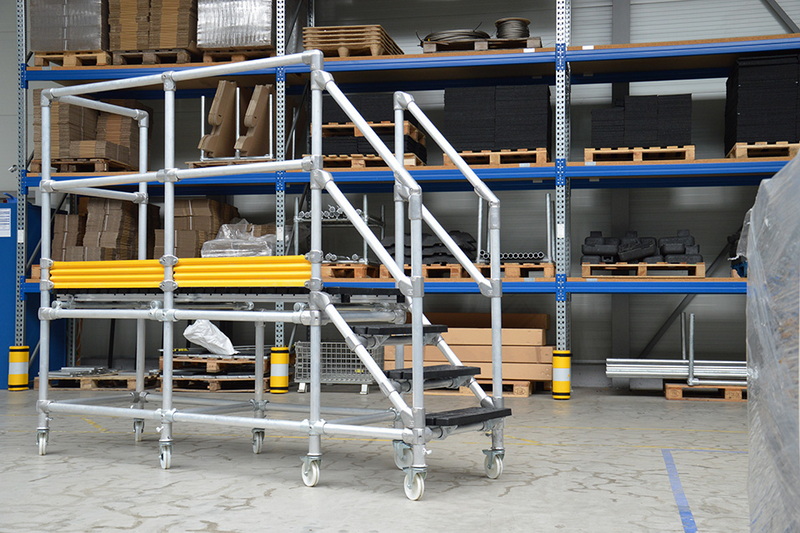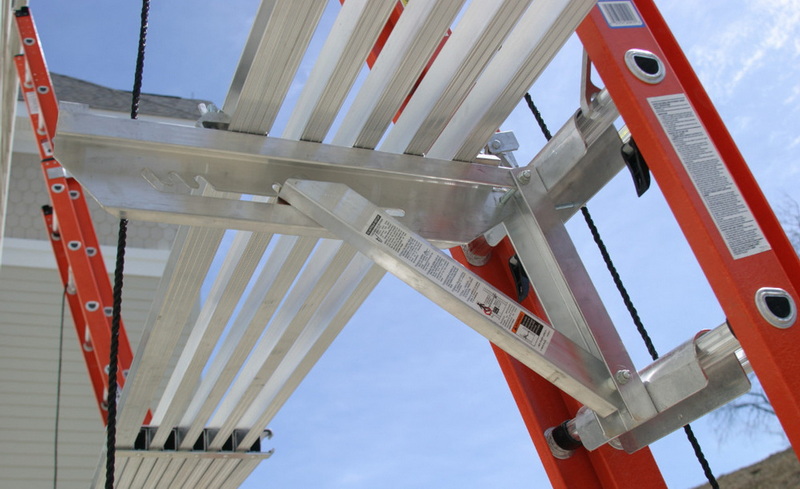Content Menu
● Understanding Ladder vs Scaffolding
>> What Is a Ladder?
>> What Is Scaffolding?
● Can a Ladder Replace Scaffolding for Large Projects?
>> 1. Project Size and Duration
>> 2. Number of Workers
>> 3. Safety and Stability
>> 4. Accessibility and Reach
>> 5. Equipment and Materials Handling
● Detailed Comparison: Ladder vs Scaffolding
● Safety Considerations
● Practical Applications
>> When Ladders Are Suitable
>> When Scaffolding Is Necessary
● Expert Opinions
● Extended Insights: Enhancing Safety and Efficiency
>> Guardrails and Safety Accessories
>> Load Capacity and Stability
>> Storage and Transportation
● Environmental and Economic Benefits
● Conclusion
● FAQ
>> 1. Can ladders be used for large construction projects?
>> 2. What are the main safety advantages of scaffolding over ladders?
>> 3. How many workers can safely use scaffolding compared to ladders?
>> 4. Is scaffolding more expensive than ladders?
>> 5. Can ladders be used safely for short-duration tasks?
When planning construction or maintenance work at heights, a critical decision is choosing the right access equipment. The debate of ladder vs scaffolding is common, especially when considering large projects. While ladders offer portability and ease of use, scaffolding provides stability and workspace. This article explores whether a ladder can replace scaffolding for large projects by analyzing their features, advantages, limitations, safety considerations, and practical applications. Supported by expert insights, it aims to guide project managers, contractors, and workers in making informed decisions.

Understanding Ladder vs Scaffolding
What Is a Ladder?
A ladder is a portable device consisting of two side rails connected by rungs or steps, designed to provide temporary access to elevated areas. Common types include step ladders, extension ladders, and platform ladders.
Advantages of Ladders:
- Lightweight and easy to transport.
- Quick and simple to set up.
- Ideal for short-duration tasks.
- Space-efficient, suitable for confined areas.
Limitations of Ladders:
- Typically supports only one worker at a time.
- Limited reach and platform space.
- Requires constant repositioning for large areas.
- Stability depends on surface and proper use.
- OSHA limits ladder use above 24 feet without fall protection.
What Is Scaffolding?
Scaffolding is a temporary elevated platform constructed from metal tubes, frames, or modular components, providing a stable workspace for workers and materials.
Advantages of Scaffolding:
- Supports multiple workers simultaneously.
- Offers large, stable platforms for tools and materials.
- Provides safer access to complex or high areas.
- Adjustable height and configuration.
- Equipped with safety features like guardrails and toe boards.
Limitations of Scaffolding:
- Requires assembly and dismantling time.
- Needs adequate space for setup.
- Higher initial cost and labor.
- Requires trained personnel for erection and inspection.
Can a Ladder Replace Scaffolding for Large Projects?
1. Project Size and Duration
For small, quick tasks at moderate heights, ladders are practical and efficient. However, large projects involving extensive work areas, multiple workers, or prolonged durations benefit significantly from scaffolding's stability and workspace.
2. Number of Workers
Ladders are designed for single-person use, limiting productivity on large projects. Scaffolding accommodates several workers simultaneously, enabling teamwork and faster completion.
3. Safety and Stability
Scaffolding provides superior stability, reducing fall risks. Ladders require maintaining three points of contact and can be unstable on uneven surfaces, especially when extended.
4. Accessibility and Reach
Scaffolding offers broad access without frequent repositioning, essential for large façades or multi-level structures. Ladders require constant moving, increasing time and risk.
5. Equipment and Materials Handling
Scaffolding platforms support tools and materials, facilitating workflow. Ladders offer no such space, often forcing workers to carry items while climbing, increasing hazards.

Detailed Comparison: Ladder vs Scaffolding
Feature | Ladder | Scaffolding |
Portability | High | Moderate |
Setup Time | Minutes | Hours |
Number of Workers | One | Multiple |
Stability | Moderate (depends on surface) | High |
Workspace | Limited (rungs only) | Large platforms |
Safety Features | Minimal | Guardrails, toe boards |
Cost | Low | Higher |
Suitable for Large Projects | Limited | Ideal |
Safety Considerations
- OSHA recommends scaffolding for work above 10 feet where extended work or multiple workers are involved.
- Ladder use requires fall protection above 24 feet.
- Scaffolding reduces fatigue by providing stable footing and workspace.
- Ladders pose higher risks of falls due to instability and limited hand use.
- Proper training and equipment inspection are critical regardless of choice.
Practical Applications
When Ladders Are Suitable
- Short, quick tasks such as changing light bulbs or minor repairs.
- Work in tight or confined spaces where scaffolding cannot fit.
- Tasks requiring frequent repositioning over small areas.
When Scaffolding Is Necessary
- Large-scale construction or renovation projects.
- Painting or finishing large walls or ceilings.
- Tasks requiring multiple workers or heavy equipment.
- Long-duration work requiring stable platforms.
Expert Opinions
Industry experts emphasize that while ladders are indispensable for many tasks, scaffolding is irreplaceable for large projects due to its safety and efficiency benefits. The consensus is to assess project requirements carefully and prioritize worker safety.
Extended Insights: Enhancing Safety and Efficiency
Guardrails and Safety Accessories
When using scaffolding, adding guardrails and toe boards enhances safety by preventing falls and tools from slipping off the platform. Many systems offer compatible accessories designed for quick installation.
Load Capacity and Stability
Understanding the load capacity of your ladder-scaffold system is vital. Always consider the combined weight of workers, tools, and materials to avoid overloading. Stability can be further improved by using outriggers or stabilizers, especially on uneven surfaces.
Storage and Transportation
Due to their foldable and compact design, ladder scaffolds are easy to transport and store. However, care should be taken to protect locking mechanisms and hinges from dirt and moisture to maintain functionality.
Environmental and Economic Benefits
Using scaffolding reduces the need for multiple pieces of equipment, lowering material consumption and waste. Their durability and reusability contribute to sustainable construction practices. Economically, these systems save money by combining functions and reducing labor time during setup.
Conclusion
While ladders are valuable tools for many construction tasks, they cannot fully replace scaffolding for large projects. Scaffolding provides a safer, more stable, and productive working environment, especially when multiple workers and heavy materials are involved. Choosing between ladder vs scaffolding depends on project size, duration, safety requirements, and accessibility needs. For large-scale or long-term projects, scaffolding remains the superior choice.

FAQ
1. Can ladders be used for large construction projects?
Ladders are generally unsuitable for large projects due to limited workspace, stability, and safety concerns.
2. What are the main safety advantages of scaffolding over ladders?
Scaffolding offers stable platforms, guardrails, and space for multiple workers and materials, reducing fall risks.
3. How many workers can safely use scaffolding compared to ladders?
Scaffolding can accommodate several workers simultaneously, whereas ladders are designed for single-person use.
4. Is scaffolding more expensive than ladders?
Yes, scaffolding has higher initial costs and setup time but increases efficiency and safety on large projects.
5. Can ladders be used safely for short-duration tasks?
Yes, ladders are appropriate for quick, low-height tasks with proper safety measures.






















